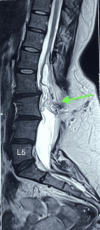Lipomeningocele with Tethered Cord Syndrome in an Adult: A Case Report
- PMID: 40802714
- PMCID: PMC10395574
- DOI: 10.31729/jnma.8220
Lipomeningocele with Tethered Cord Syndrome in an Adult: A Case Report
Abstract
Lipomeningocele is a closed neural tube defect characterized by the presence of spinal tissue within the spinal cord, with a junction between the spinal cord and a lipoma. It has a prevalence of 0.6 per 10,000 live births. A 29-year-old female presented to the outpatient clinic with complaints of weakness in both legs (more on the right) and tingling sensation and pain over her right thigh and legs for 1 year. She also mentioned swelling in her lower back since birth, which has been growing progressively since childhood. Magnetic resonance imaging of the spine revealed a low-lying spinal cord with the conus lying at the lower end of the L2 vertebral body. Spinal decompression with detethering of the cord and excision of the lipomeningocele was undertaken via a posterior midline incision. Prompt surgical intervention are crucial for symptom relief and prevention of neurological deterioration.
Keywords: case reports; lipoma; spinal dysraphism; tethered cord syndrome.
© The Author(s) 2023.
Conflict of interest statement
None.
Figures
Similar articles
-
Prescription of Controlled Substances: Benefits and Risks.2025 Jul 6. In: StatPearls [Internet]. Treasure Island (FL): StatPearls Publishing; 2025 Jan–. 2025 Jul 6. In: StatPearls [Internet]. Treasure Island (FL): StatPearls Publishing; 2025 Jan–. PMID: 30726003 Free Books & Documents.
-
Spinal Epidural Abscess: Raising the Index of Suspicion.Cureus. 2025 Jun 6;17(6):e85465. doi: 10.7759/cureus.85465. eCollection 2025 Jun. Cureus. 2025. PMID: 40621306 Free PMC article.
-
Cervical Degenerative Disc Disease.2025 Aug 2. In: StatPearls [Internet]. Treasure Island (FL): StatPearls Publishing; 2025 Jan–. 2025 Aug 2. In: StatPearls [Internet]. Treasure Island (FL): StatPearls Publishing; 2025 Jan–. PMID: 32809607 Free Books & Documents.
-
The Black Book of Psychotropic Dosing and Monitoring.Psychopharmacol Bull. 2024 Jul 8;54(3):8-59. Psychopharmacol Bull. 2024. PMID: 38993656 Free PMC article. Review.
-
[Volume and health outcomes: evidence from systematic reviews and from evaluation of Italian hospital data].Epidemiol Prev. 2013 Mar-Jun;37(2-3 Suppl 2):1-100. Epidemiol Prev. 2013. PMID: 23851286 Italian.
References
Publication types
LinkOut - more resources
Full Text Sources

